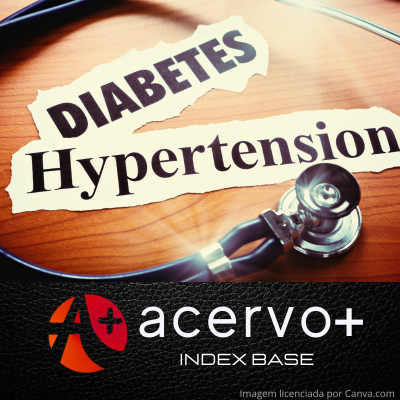Diabetes mellitus e hipertensão arterial: uma análise comparativa de fatores de risco e desfechos clínicos
##plugins.themes.bootstrap3.article.main##
Resumo
Objetivo: Realizar uma análise comparativa dos fatores de risco e desfechos clínicos de pacientes atendidos em um hospital universitário da região Nordeste do país. Métodos: Estudo descritivo transversal realizado pela análise de 23 prontuários de pacientes diagnosticados com hipertensão e diabetes mellitus internados no hospital universitário entre março de 2018 e março de 2023. Resultados: 73,91% dos pacientes internados eram do sexo masculino e 47,82% tinham mais de 70 anos de idade. No que se refere ao perfil sociodemográfico, grande parte (34,78%) possuía educação até o nível fundamental incompleto. Observou-se que 26,08% dos pacientes apresentavam pé diabético e 21,73%, complicações vasculares. Dados clínicos revelaram que 13,04% dos pacientes haviam passado por amputações, consequência de ulcerações irreversíveis associadas ao pé diabético. Quanto aos exames laboratoriais, observou-se que, de 17 pacientes com registros de hemoglobina glicada (HbA1c), 14 apresentavam valores acima do limite, enquanto apenas 2 indivíduos, de um total de 10 com registros de pressão arterial, ultrapassavam o valor máximo. Conclusão: Conclui-se que os desfechos majoritários foram o pé diabético, aterosclerose e infecção em membros amputados. Aspectos comuns, como idade e gênero, surgiram como fatores de risco proeminentes.
##plugins.themes.bootstrap3.article.details##
Copyright © | Todos os direitos reservados.
A revista detém os direitos autorais exclusivos de publicação deste artigo nos termos da lei 9610/98.
Reprodução parcial
É livre o uso de partes do texto, figuras e questionário do artigo, sendo obrigatória a citação dos autores e revista.
Reprodução total
É expressamente proibida, devendo ser autorizada pela revista.
Referências
2. ANDRADE JU, et al. Adesão ao regime terapêutico de pacientes com diabetes Mellitus: análise de atividades de autocuidado. Brazilian Journal of Development, 2020; 6(7): 48115-48129.
3. BEASON-HELD LL, et al. Longitudinal Changes in Cerebral Blood Flow in the Older Hypertensive Brain. Stroke, 2007; 38(6): 1766–1773.
4. BRASIL. Ministério da Saúde. 2020. Disponível em: https://www.gov.br/saude/pt-br/assuntos/noticias/2020/maio/diabetes-hipertensao-e-obesidade-avancam-entre-os-brasileiros-3. Acessado em: 03 de dezembro de 2023.
5. BRASIL. Ministério da Saúde. Definição – Hipertensão Arterial Sistêmica (HAS) no adulto, 2023. Disponível em: https://linhasdecuidado.saude.gov.br/portal/hipertensao-arterial-sistemica-(HAS)-no-adulto/definicao-hipertensao-arterial-sistemica-has-no-adulto/. Acessado em: 01 de abril de 2023.
6. BRENNER BM, et al. Effects of Losartan on Renal and Cardiovascular Outcomes in Patients with Type 2 Diabetes and Nephropathy. New England Journal of Medicine, 2001; 345(12): 861–869.
7. CHERBUIN N, et al. Higher normal fasting plasma glucose is associated with hippocampal atrophy: The PATH Study. Neurology, 2012; 79(10): 1019–1026.
8. CRUICKSHANK K, et al. Aortic Pulse-Wave Velocity and Its Relationship to Mortality in Diabetes and Glucose Intolerance. Circulation, 2002; 106(16): 2085–2090.
9. CUNHA RC, et al. Burden of diabetes mellitus and hypertension overuse in a Brazilian public primary care setting: A cross-sectional study. BMC Health Services Research, 2021; 21(1): 1-9.
10. ELKINS J, et al. Pre-existing hypertension and the impact of stroke on cognitive function. Annals of Neurology, 2005; 58(1): 68–74.
11. INTERNATIONAL DIABETES FEDERATION (IDF). IDF Diabetes Atlas. 10th ed. Brussels, Belgium: IDF; 2021.
12. IRIE F, et al. Enhanced Risk for Alzheimer Disease in Persons With Type 2 Diabetes and APOE ε4. Archives of Neurology, 2008; 65(1).
13. LEWIS EJ, et al. Renoprotective effect of the angiotensin-receptor antagonist irbesartan in patients with nephropathy due to type 2 diabetes. The New England journal of medicine, 2001; 345(12): 851–60.
14. LI S, et al. The prevalence and temporal trends of hypertension, diabetes mellitus and dyslipidemia in Chinese adults: A cross-sectional study from 2010 to 2015. Lipids in Health and Disease, 2021; 20(1): 1-11.
15. LIPSKY BA, et al. 2012 Infectious Diseases Society of America Clinical Practice Guideline for the Diagnosis and Treatment of Diabetic Foot Infections. Clinical Infectious Diseases, 2012; 54(12): e132–e173.
16. LIVINGSTON G, et al. Dementia prevention, intervention, and Care. The Lancet, 2017; 390(10113): 2673–2734.
17. NATHAN DM, et al. Translating the A1C Assay Into Estimated Average Glucose Values. Diabetes Care, 2008; 31(8): 1473–1478.
18. RAINA P, et al. Effectiveness of Cholinesterase Inhibitors and Memantine for Treating Dementia: Evidence Review for a Clinical Practice Guideline. Annals of Internal Medicine, 2008; 148(5): 379.
19. SCHMIDT MI, et al. Prevalence, awareness, treatment, and control of high blood pressure in Brazil. American Journal of Hypertension, 2011; 24(3): 361-368.
20. SOCIEDADE BRASILEIRA DE DIABETES (SBD). Diretrizes da Sociedade Brasileira de Diabetes. 2023. Disponível em: https://diretriz.diabetes.org.br/. Acessado em: 26 de março de 2023.
21. SOCIEDADE BRASILEIRA DE HIPERTENSÃO (SBH). Hipertensão arterial. 2022. Disponível em: http://www.sbh.org.br/hipertensao-arterial/. Acessado em: 26 de março de 2023.
22. VERDELHO A, et al. White matter changes and diabetes predict cognitive decline in the elderly: The LADIS Study. Neurology, 2010; 75(2): 160–167.
23. VIAZZI F, et al. Long-term blood pressure variability and development of chronic kidney disease in type 2 diabetes. Journal of Hypertension, 2019; 37(4): 805–813.
24. WANG LY, et al. Blood Pressure and Brain Injury in Older Adults: Findings from a Community-Based Autopsy Study. Journal of the American Geriatrics Society, 2009; 57(11): 1975–1981.
25. ZHANG Y, et al. Prevalence of hypertension and diabetes mellitus in various regions of the world: A systematic review and meta-analysis. Medicine, 2021; 100(33): e26776.

